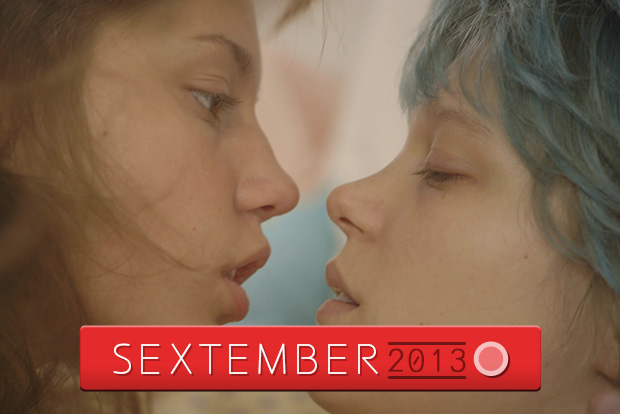SEXtember: Blue is the Warmest Colour
HOW truthful is the depiction of sex on film? This SEXtember, we observe the controversy surrounding award-winning film, Blue Is The Warmest Color and the discourse that it has inspired.
In May this year, French film, Blue is the Warmest Colour was the toast of the French Riviera and the wider film industry.
The film was awarded the Palme d’Or at the 66th Cannes Film Festival – the highest and most coveted prize for a feature film at the prestigious film festival.
Against a backdrop of same-sex marriage debates, the contemporary French drama was highly praised for its emotionally raw and sexually explicit portrayal of a love story between two young women.
Since the Palme d’Or victory however, the film has been embroiled in a string of controversies, and now appears to have been strangely denounced by all parties involved, including its director and lead actresses.
At the centre of all the issues and debate is a lengthy and graphic sex scene that saw the two lead actresses of the film completely naked, writhing, embracing and engaging in all manners of physical intimacy.
It was this very same sex scene that had initially garnered the film much critical acclaim and recognition at Cannes.

An explicit sex scene between the two lead actresses in the film has been the centre of the film’s controversy with some labelling it as bordering on pornography.
Julie Maroh, author of the graphic novels upon which the movie was based, was one of the first to voice her criticisms, stating that the film made her feel “ill at ease” with its uninformed and unconvincing portrayal of lesbian sexual relationships.
“This brutal, surgical display of so-called lesbian sex… was turned into porn,” wrote Ms Maroh on her blog and alleged the film could only be appreciated by “men who were too busy feasting their eyes on incarnations of their fantasies”.
Her sentiments were echoed by a number of film critics and commentators across the industry – most of whom are female.
Amy Taubin, a member of the selection committee for the New York Film Festival, admitted the film felt “extremely voyeuristic”.
“[The actresses] are made to look ridiculously, flawlessly beautiful,” Ms Taubin said.
Manohla Dargis, co-chief film critic at the New York Times, agreed and opined the movie felt “far more about Mr Kechiche’s desires than anything else”.

Backlash to the film has also been attributed to the film’s leading female stars, both of whom felt the 10-minute sex scene in the film was embarrassing.
However, a number of academics have noted that whilst the controversies centre on the nature and value of explicit depictions of sexual encounters in cinema, it is heightened dramatically by the stigma in representation and exploitation of homosexual female relationships in cinema.
This was a point echoed by Jordan Mintzer, a film critic for The Hollywood Reporter.
In an opinion article for The New York Times, he wrote: “presumably, this [fuss] is because it’s one of the first art house movies to so explicitly portray same-sex female copulation. The fact that a heterosexual man directed drew the ire of certain critics, who challenged its perverse ‘male gaze’”.
So the true question remains – if such a lengthy and explicit sex scene had portrayed heterosexual physical intimacy, would its graphic and ‘unrealistic’ depiction bring about such outrage in the community?
In formulating an answer, one should perhaps look to the number of successful TV shows, movies, and perhaps even music videos in recent times.

HBO’s Game of Thrones depicts heterosexual and homosexual sex though though its depiction is more sensationalised and hyperbolic.
Putting aside the image of Miley Cyrus twerking everywhere and anywhere and swinging naked on a wrecking ball, there are still a vast amount of ‘airbrushed’ sex and eroticism both in television and on the big screen.
The success of HBO shows such as Sex and the City, Entourage, and more recently, Game of Thrones have all contained graphic (if not lengthy) depictions of sexual encounters – both heterosexual and homosexual – none of which could be convincingly said to be a “realistic portrayals” of a sexual relationship.
Whilst sexual representation in movies, especially for minorities, can be seen as a part of an important political discourse as argued by Mirelle Miller-Young, Elizabeth Lansen, an academic at Columbia University, views it necessary to remember that the “cinema is an inherently voyeuristic medium”, and that cinematic portrayals of women are often automatically seen to be exploitation and voyeuristic – even if they are not necessarily so.
Cinematic portrayals are generally some form of hyperbole – an exaggerated version of reality – with aspects dramatized for the pleasure and enjoyment of the viewer. In this sense, depictions of sex and physical intimacy are no different.
…a bad sex scene divorces eroticism from its characters’ emotions, while a good sex scene brings emotion into the physical act.” – Armond White, film critic
In fact, one would be hard-pressed to think of a ‘realistic’ sex scene in which the protagonists are faced with all the awkwardness that could arise in real life, such as cellulite, love handles, strained positional changes and awkward bodily functions such as perspiration or the much-dreaded gas release.
Therefore, if explicit depictions of heterosexual physical intimacy are allowed a degree of artistic license as to “airbrushing”, should portrayal of lesbian sex really be confined to being “realistic”?
Blue is the Warmest Colour may have depicted sex in an unrealistically perfect manner, however, it also portrayed the emotional state of the protagonists involved and cannot be said to be a purely “pornographic” creation for the voyeuristic desires of lewd perverse men.
As Armond White, editor-in-chief and film critic for CityArts, concluded: “…a bad sex scene divorces eroticism from its characters’ emotions, while a good sex scene brings emotion into the physical act”, which Blue is the Warmest Colour has precisely been praised for achieving.
